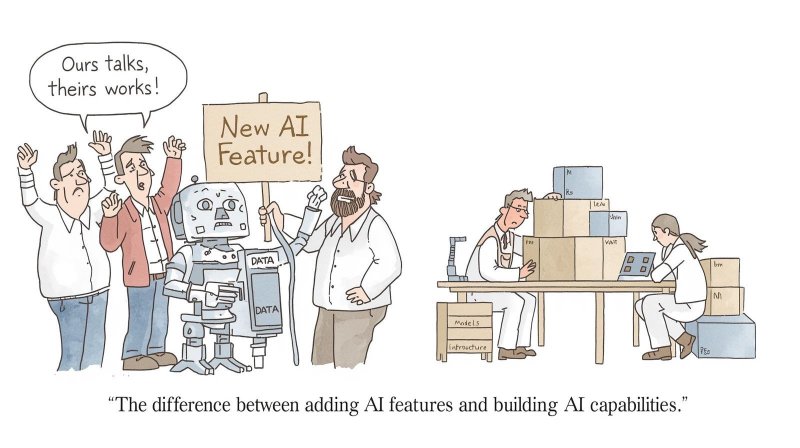The AI Strategy Gap: Why Most Companies Still Don’t Have One
Updated:
5 minutes

We’ve reached the stage where “AI-powered” is the new “cloud-native”. You’ll find it on every investor deck, every roadmap, and every product release. Yet behind the buzzwords, something’s missing: a real plan for how AI will change the business, not just the interface.
Every company claims to have an AI strategy. In practice, most just have a roadmap sprinkled with AI features. The gap isn’t technical. It’s conceptual. Most companies are adding AI features — very few are building AI capabilities.
AI as a Feature vs. AI as a Capability
Treating AI as a feature means applying it at the edge of an existing product. It’s additive — a way to enhance user experience, improve efficiency, or signal innovation. You can recognize it instantly:
- The “AI roadmap” sits inside the product backlog.
- The conversation starts with “where can we add AI?”
- The goal is to delight users, not to build leverage.
That’s fine — it creates visible progress. But it’s also inherently shallow. Feature-level AI doesn’t compound. Each new experiment starts from scratch because the underlying data, infrastructure, and feedback loops aren’t shared. This is why teams default to adding chatbots to everything instead of thinking about how intelligence should be embedded into workflows.
By contrast, AI as a capability is about internalizing AI as an organizational muscle — a reusable system that helps the company learn, decide, and differentiate faster over time. When a company builds AI capabilities, it’s investing in:
- Shared data foundations: clean pipelines, accessible metadata, consistent governance.
- Reusable components: embeddings, prompts, APIs, and internal models that can be applied across products.
- Feedback systems: mechanisms to capture outcomes and close the learning loop.
- Cross-functional fluency: where product, data, and domain experts co-own the outcomes.
The question shifts from “where can we add AI?” to “how do we design for AI across everything we build?” The difference isn’t semantic — it’s strategic gravity. AI features pull value toward the product. AI capabilities pull value toward the organization.
Features make you look innovative. Capabilities make you learn faster than your competitors. And that’s much harder to copy.
Why the Strategy Gap Exists
Most organizations don’t have an AI strategy problem — they have an AI ownership problem.
AI often lives too low in the hierarchy. It’s owned by product teams chasing delivery velocity, or data teams chasing model performance. But strategy sits above both. It’s about how AI changes the way the business learns and competes.
Several patterns explain the gap:
- Feature Myopia: AI is treated as a short-term differentiator rather than a long-term capability builder.
- Data Debt: messy data infrastructure makes meaningful AI investments impossible.
- Short-termism: leadership optimizes for quarterly updates and flashy demos.
- Fear of Complexity: AI operations are perceived as “too R&D,” so they never graduate to core systems.
As a result, many AI “initiatives” remain disconnected from product strategy. They create local wins but no global advantage. The company ends up renting intelligence from external APIs instead of building its own institutional knowledge loop.
What an Actual AI Strategy Looks Like
A credible AI strategy starts with intent, not integration. It connects the technology to the business model. At its core, it should answer five questions:
- Where will AI create structural advantage? Not every workflow benefits equally. Choose domains where data, scale, or proprietary context give you leverage.
- What data strategy supports that vision? Treat data as an asset, not a byproduct. Curate, label, and govern it so it compounds over time.
- What capabilities need to exist internally? Identify which layers — infrastructure, modeling, evaluation, human-in-the-loop — must live inside the company to ensure control and differentiation.
- How will teams experiment safely and repeatedly? Build shared experimentation frameworks. Measure learning velocity, not just feature output. A framework like the one in How to Evaluate AI Use Cases That Actually Move the Needle helps ensure you’re choosing projects that build capabilities, not just features.
- What cultural and ethical guardrails apply? Responsible use of AI isn’t a compliance checkbox; it’s a trust advantage.
In other words: a real AI strategy is less about what you build this quarter, and more about what you’ll learn faster than others over the next five years.
The Emerging Divide
In the next few years, the gap between “AI users” and “AI organizations” will widen quickly.
The first group will rely heavily on API wrappers, off-the-shelf copilots, and pre-trained models. Their AI features will look impressive — until everyone else ships the same thing a month later.
The second group will quietly invest in internal data pipelines, model governance, and experimentation loops. Their advantage won’t be visible on launch day, but it will compound. Every new product, every user interaction, every model fine-tune will feed back into the system — accelerating the next cycle.
That’s the compounding effect of AI capabilities: the more you use them, the smarter your organization gets.
From AI Features to AI Fluency
If your “AI strategy” fits on a single roadmap slide, you probably don’t have one yet.
AI fluency — the ability to understand, design, and iterate with AI across the business — is what separates organizations that adapt from those that simply adopt. It’s not about hiring a Chief AI Officer or spinning up a new lab. It’s about changing how teams think about learning, data, and differentiation. Building this fluency requires organizational discipline — the cross-functional muscle to ship AI reliably, not just experimentally.
AI isn’t the next feature. It’s the next foundation.